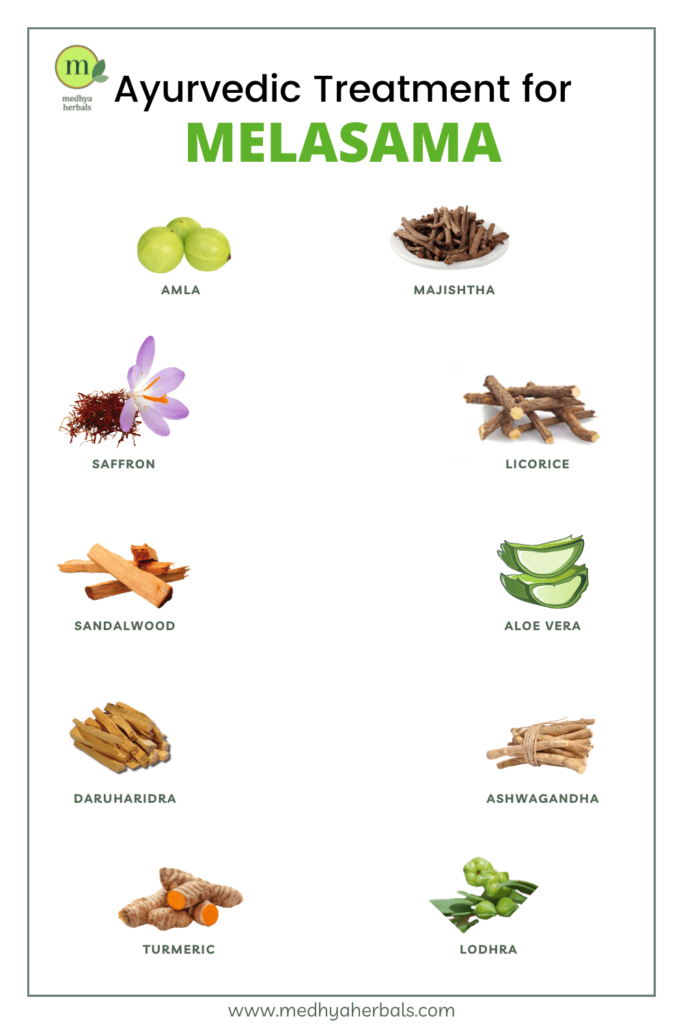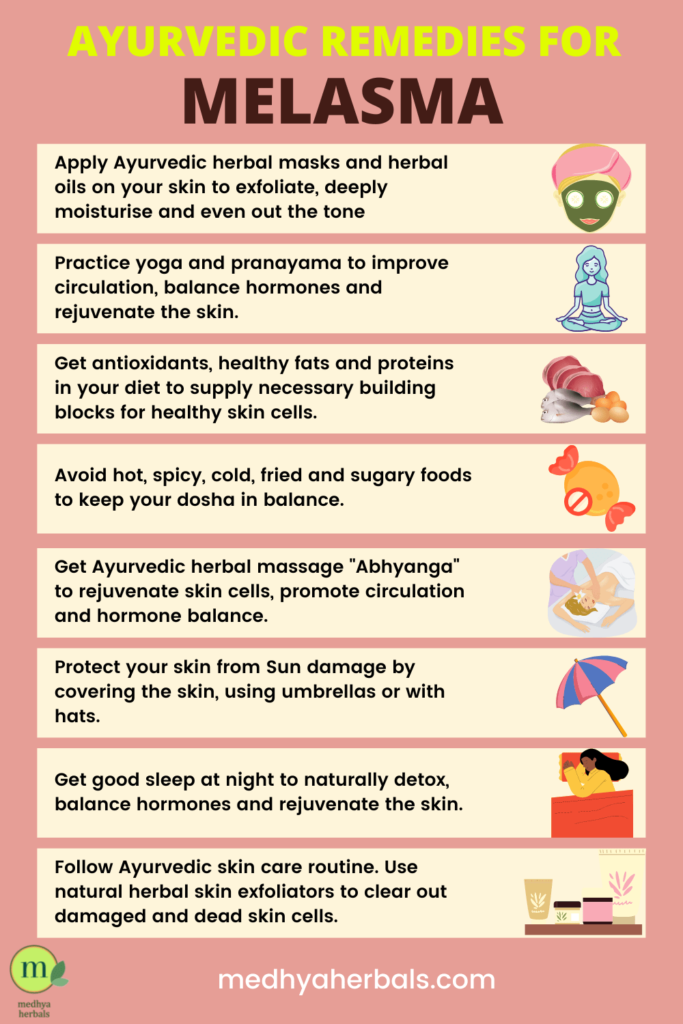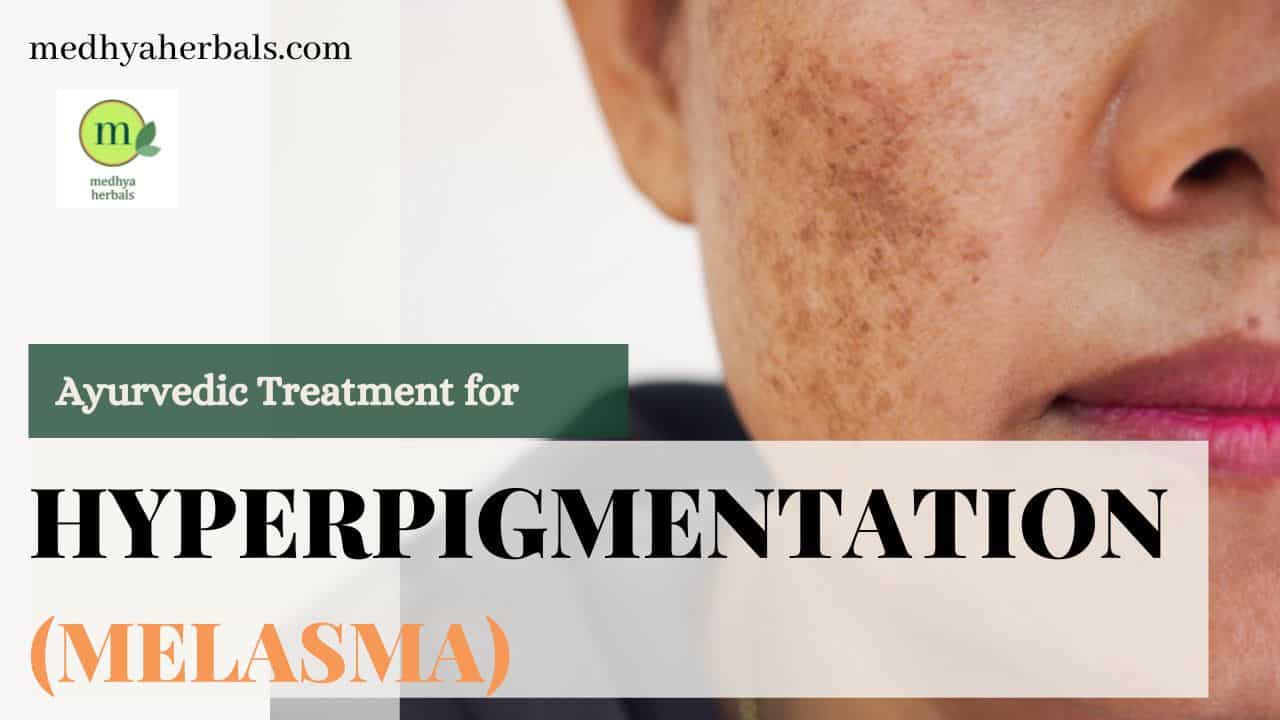While melasma is harmless, it is discomforting knowing that you have all these dark spots on the face that have refused to clear up no matter what you do or what you try. You feel self-conscious about your appearance because of the black dots and dark patches on your skin that this hyperpigmentation disorder has caused.
Skin pigmentation, which is a term used interchangeably with hyperpigmentation, is a skin ailment that is characterized by dark spots on the skin. Any part of the skin could be affected by skin pigmentation, but mostly, the part where it occurs and bothers the most is the face.
If you are looking for a natural way to treat hyperpigmentation caused by melasma, Ayurvedic treatment may be the right choice for you. Ayurveda is an ancient system of medicine from India that uses herbs, diet, and healthy lifestyle as measures to treat an individual’s specific health symptoms.
In this post, we will go through causes, symptoms and Ayurvedic treatment for skin discoloration, hyperpigmentation and melasma. We will also look into Ayurvedic skincare routine that will help you to attain a healthy glowing skin. Let’s begin!
What Causes Dark Spots on the Face and Body?
Skin pigmentation is the discoloration skin due to an excess of melanin, the pigment that gives skin its color. While melanin is normally produced in response to sunlight exposure, a number of factors can lead to an overproduction of melanin, resulting in dark patches on the skin.
1. Excess Sun Exposure leading to Skin Damage
This is probably the chief cause. Remember that the purpose of the melanin is to protect the skin from these UV rays in the first place. When the skin is exposed to more of these rays, the melanocytes are forced to produce more melanin in order to compensate for the increased sun exposure.
The most common type of hyperpigmentation due to excessive sun exposure is freckles, sunspots, solar lentigines, or liver spots. It can happen at a very young age in kids. You can prevent this by protecting and covering the skin when outside.
While skin tone after sun tan is really sought after, the truth is that a tan is a certain sign of skin damage. It indicates that the skin, particularly the melanocytes, are being overworked. If the damage is left to accumulate over time, it can lead to cancer.
2. Stress
Excessive physical, mental or emotional stress can cause or make hyperpigmentation problem worse. Stress affects our sleep, circulation and digestion. Thus, it directly and indirectly leads to poor nourishment and inflammation in the skin.
You can easily notice skin problems such as hyperpigmentation, wrinkles, premature aging ofskin, patchy and uneven skin tone, dry skin, acne, and dark circles; cropping up when you go through periods of stress.
3. Hormonal Imbalances
Another common cause of these skin pigmentation is hormonal imbalances. For example, during pregnancy when there is a surge in the level of hormones, like estrogen; it can lead to pigmentation of the skin.
Melasma is a type of hyperpigmentation of the skin that appears in the form of brown or gray patches. It can occur on the face (cheeks and forehead), neck, chest, back, or other areas of the body that are exposed to the sun.
Skin discoloration and pigmentation as melasma can be observed due to Hormone Therapy, PCOS, in perimenopause or post Menopause.
4. Post Inflammatory Skin Pigmentation
Skin damage through rashes, acne, burns, psoriasis, skin rubbing, and sometimes due to harsh skincare treatments can lead to dark spots, uneven skin tone and skin pigmentation.
The skin healing process involves the removal of dead cells from the skin. This is done by enzymes called collagenases, which break down the collagen that holds these cells to the skin.
However, this collagen is not completely replaced when new cells are being made to occupy the space of the new cells. As a result, pigments are recruited to protect the wounded skin, leading to formation of scars.
5. Yeast or Fungal Infections
Fungal infections often cause the body to produce more melanin in an attempt to protect the skin from further damage. In addition, certain types of fungi release chemicals that can directly stimulate the production of melanin.
As a result, fungal infections are a common cause of skin pigmentation. If you notice dark patches on your skin, it is important to see a doctor for a diagnosis and treatment. Left untreated, fungal infections can lead to further skin pigmentation and other problems.
6. Chemicals
A patch of skin can be irritated due to exposure to chemicals from skin care products used, chemicals such as salicylcic acids, bleomycin, etc, or mercury poisoning.
7. Medications and Medical Conditions
Skin pigmentation can also be affected by certain medications, such as birth control pills or antipsychotic drugs. In some cases, skin pigmentation can be a sign of an underlying health condition, such as diabetes, kidney disease, PCOS, Hypothyroidism or Gastrointestinal disorders.
Hyperpigmentation and Dark Spots on the Face
Generally, in pigmentation some parts of the skin turn darker than the others. However, since the skin of the face has two times more pigments than the skin on any part of the body.
That’s why, it is more vulnerable to pigmentation related skin problems such as dark spots on the face. Thus, it becomes even more important to take care of your facial skin to protect it from sun damage and other causative factors of pigmentation.
Hyperpigmentation: An Ayurvedic View
As a holistic medicine, Ayurveda isn’t only concerned about treating the pigmentation, but also the underlying cause. After all, being the largest organ of the body and stretching across the whole body, the skin is connected in many ways to the systems of the body.
Thus, skin problems are indicative of a deeper underlying problem than that spot presenting on the skin.
In Ayurvedic medicine, hyperpigmentation is referred to as “Vyanga” or “Neelika.” It is caused by an imbalance in the vata dosha (air and space) and pitta dosha (fire and water), which regulate skin tone and skin health in general. This imbalance then causes the hyperpigmentation disorder.
Ayurvedic Treatment for Hyperpigmentation
Ayurveda provides effective treatment options that not only remove the hyperpigmentation of the skin but also treat the root cause of melasma so that dark spots do not reappear.
Ayurveda can help you treat skin disorders caused by the elevated dosas with herbal remedies, Ayurvedic medicine, nourishing diet, yoga and physical therapies such as skin masks and herbal oil massages.
1. Ayurvedic Medicine for Hyperpigmentation Treatment

Ayurvedic medicine has been used for centuries to treat a variety of skin ailments, including melasma. Ayurvedic herbs are nutrient dense plant based formulations that depply nourish and rejuvenate the skin.
Here is a list of highly effective Ayurvedic remedies for hyper pigmentation and skin disorders:
1. Licorice: It is one of the most popular Ayurvedic herbs for melasma treatment. It has natural bleaching properties that help in fading away the dark spots and pigmentation.
2. Neem: It is another popular Ayurvedic herb known for its skin lightening properties. Neem is a powerful antioxidant that helps to lighten skin tone and reduce pigmentation. A paste made from neem leaves and turmeric can be applied on the affected area to help get rid of melasma.
3. Aloe vera: Aloe vera has natural skin lightening properties that can help fade away the dark spots and pigmentation caused by melasma.
4. Turmeric: It is a popular Ayurvedic herb that has natural bleaching properties. Turmeric is a potent anti-inflammatory agent that inhibits the production of melanin. It can be used to treat melasma by applying a paste of turmeric and milk on the affected area.
5. Sandalwood: Sandalwood is another popular Ayurvedic herb known for its skin lightening properties. A paste of sandalwood and rosewater can be applied on the affected area to help get rid of melasma.
6. Amla: It is the richest source of Vitamin C and a popular Ayurvedic herb known for its natural bleaching properties. Amla juice or paste made from dried powder can be applied on the affected area to help lighten the dark spots and pigmentation caused by melasma.
7. Saffron: Saffron is another popular Ayurvedic herb known for its natural bleaching properties. A paste of saffron and milk can be applied on the affected area to help lighten the dark spots and pigmentation caused by melasma.
8. Fenugreek: It is an Ayurvedic herb that has natural skin lightening properties. Fenugreek seeds can be made into a paste and applied on the affected area to help get rid of melasma.
9. Majishtha: It is an Ayurvedic herb that has natural skin lightening ad blood purifying properties. It has a sweet, bitter, and acidic taste and is an effective pitta pacifier. Manjishtha can be taken internally or applied in the form a paste along with other herbs. Regular use of Manjishtha supports younger-looking healthy skin that is free of melasma.
10. Guduchi: It has been traditionally used in Ayurveda to treat various skin disorders. Clinical studies have shown that guduchi extract helps to lighten skin tone and reduce pigmentation.
2. Ayurvedic Lifestyle to Prevent Melasma & Hyperpigmentation

A healthy lifestyle is also important in preventing melasma from developing or worsening. Ayurveda suggests protecting the skin from excessive sun exposure and intake of healthy diet rich in antioxidants for blemish free healthy skin.
Here are some Ayurvedic lifestyle tips for you to follow:
- Reduce exposure to sunlight. Use of sunscreen with Sun Protection Factor(SPF) of at least 30.
- If outside under the Sun, then reapply sunscreen every three to four hours, as sweat washes it off.
- Wear wide brimmed hats and sunglasses to protect your face and eyes from excess sun exposure. alternatively, you can use umbrellas.
- Follow Ayurvedic skin care routine. Use natural herbal skin exfoliators to clear out damaged and dead skin cells.
- Get good sleep at night to naturally detox, balance hormones and rejuvenate the skin.
- Apply Ayurvedic herbal masks and herbal oils on your skin to exfoliate, deeply moisturise and even out the tone
- Practice yoga and pranayama to improve circulation, balance hormones and rejuvenate the skin.
- Get Ayurvedic herbal massage “Abhyanga” to rejuvenate skin cells, promote circulation and hormone balance.
3. Ayurvedic Diet Changes for Melasma and Dark Spots on the Face
Hyperpigmentation is caused by an imbalance in pitta and vata doshas. Thus, you should eat a vata pitta balancing diet to prevent and cure Melasma.
- Eat seasonal juicy fruits.
- Get antioxidants, healthy fats and proteins in your diet to supply necessary building blocks for healthy skin cells.
- Embrace cucumbers, barleys, legumes, bell pepper, barleys, broccoli, buck wheat.
- Prefer smaller meals during the day and do not hold hunger. Always take timely meals at fixed time everyday.
- Take warm and unctuous foods such as porridges, curries, gruels, and soups.
- Include spices and herbs to maintain healthy digestive fire and to get the micronutrients.
- Avoid hot, spicy, cold, fried and sugary foods to keep your dosha in balance.
- Remove chilli and sugar from the diet. Both of these cause excessive stimulation and push Vata out of balance.
- Remove cold temperature foods and drinks.
- Limit or stop raw foods such as salads.
Conclusion
If you are concerned about hyperpigmentation or skin discoloration, then Ayurvedic treatment for melasma may be worth considering. Ayurvedic herbs and home remedies can be used to help lighten the skin and reduce the appearance of pigmentation.
Speak to an Ayurvedic practitioner at Medhya Herbals if you would like more information about how Ayurveda can help you achieve clear, radiant skin.
FAQ
1. Which Ayurvedic medicine is best for pigmentation?
Ayurveda practitioners believe that many diseases, including pigmentation disorders such as melasma, can be treated by addressing the underlying imbalance. There are a number of different Ayurvedic medicines that are effective for treating pigmentation disorders.
Some of the most popular Ayurvedic treatments for melasma include turmeric powder, neem, and aloe vera gel. These natural remedies work to correct the underlying imbalance that is causing the pigmentation disorder.
In addition, Ayurvedic practitioners may also recommend lifestyle changes, such as reducing stress levels and controlled sun exposure, as part of the treatment plan.
2. What is skin pigmentation?
Skin pigmentation is a spot or a group of spots that appear on the skin. It could manifest as freckles, age spots, melasma, post inflammatory pigmentation, or dark circles.
Skin pigmentation can be due to a number of factors, including genetics, sun exposure, and certain medical conditions. The pigmentation of the skin is determined by the amount of melanin present.
Melanin is a pigment that is produced by cells in the skin called melanocytes. When these cells are exposed to sunlight, they produce more melanin in order to protect the skin from harmful UV rays. The amount of melanin in the skin can also be affected by certain medical conditions, such as Addison’s disease or vitiligo.
If you have any concerns about your skin pigmentation, you should speak to an Ayurvedic practitioner or dermatologist.
3. What causes Melasma?
Melanin is widely responsible for melasma. Melanin is the pigment that gives the skin its dark coloration. It is produced in the melanocytes in the skin. However, if these melanocytes begin overproducing melanin, it results in skin pigmentation disorders, such as melasma, and dark spots can be seen forming on the skin.
The causes for melasma are very widely varying, and are not always specific, but there are factors that put one at increased risk of melasma and these are related to these detailed causes of hypermelanosis disorders like hyperpigmented skin.
4. What are the Risk Factors for Melasma?
Melasma is a skin problem that affects all persons and all races, but Asians and Hispanics have been found to be more susceptible. Also, it mostly affects middle-aged women of child-bearing age, women of about ages twenty to forty.
Because of its prevalence in this age group, melasma is also referred to as chloasma, the mask of pregnancy.
In India for example, 20-30% of 40-65 year old women have facial melasma. Other people who are more at risk of melasma are those whose skin tone is darker, and those who have a family history of melasma, that is to say, some people are genetically predisposed to melasma.
- Sun Exposure
- Darker Skin
- Pregnancy
- Hormone therapy
- Cosmetics
- Drugs
- Nutritional deficiency, digestive disorders
- Diabetes, Hypothyroidism, PCOS and Hormonal Imbalances
5. What does Melanin do?
The skin is a protective layer over the whole body, and it is packed with features to enable it serve its protective function. One of those features is melanin.
Melanocytes, cells in the deeper layers of the skin, produce these melanin pigments, package them in small packets called melanosomes, and send them to the surface of the skin, where they give the skin it’s dark color. You would have guessed, the more melanin a person has, the darker that person is.
As mentioned earlier, this melanin is intended for protecting the skin, and it shields the skin from ultraviolet rays (UVA and UVR) that come from the sun.
You have more questions? Comment below, and our in-house experts in Ayurveda will respond to you promptly.
6. Why does your skin develop Hyperpigmentation?
Hyperpigmentation, like many other skin disorders, generally occurs as a result of an imbalance in the rate of production of melanin by those cells called melanocytes.
Melanin is the pigment that gives the skin it’s color. The word ‘pigment’, actually translates to color.
Melanin periodically gets sloughed off the surface of the skin and then replaced. However, when these melanocytes underproduce melanin, the replacement of the lost pigments is not done quickly enough, causing the skin to turn pale and lose color.
However, when these cells become hyperactive, there is an excess of melanin, resulting in dark spots or dark patches in the areas where hyperactive melanocytes are located. Thus, it is these dark patches that are then referred to as skin hyperpigmentation or dark spots on the face.
7. Can Cosmetic Treatment for Hyperpigmentation solve the problem of Dark Spots on the Face?
There are many quick fixes for hyperpigmentation. Dermatologists would usually recommend the use of face acids, dermabrasion, microdermabrasion, laser peels, chemical peels, etc.
While majority of these solutions can give immediate results for pigmentation disorders, they usually damage the acid mantle of the skin, which is a natural protective layer of oils and fats on the surface of the skin.
Aside this, with most of these treatments, another therapy or session of it is usually needed after three to five months because the pigmentation will begin to appear again.
This is because the skin discoloration was only removed at a superficial level, but the underlying problems have not been addressed.
8. How long it takes to clear up or cure Melasma?
There is no one-size-fits-all answer to this question, as the time it takes to cure Melasma will vary from person to person. However, most people find that with ayurvedic treatment for Melasma, their condition begins to improve within a few weeks. For best results, it is recommended that you continue using the remedy for at least three months.
References
Management of Vyanga (facial melanosis) with Arjuna Twak Lepa and Panchanimba Churna
Dermatological Manifestations in Ayurveda:A Review
A CONCEPTUAL STUDY OF VYANGA (MELASMA) IN AYURVEDA W.S.R SAUNDARYA OF SKIN CLINICAL TYPES

